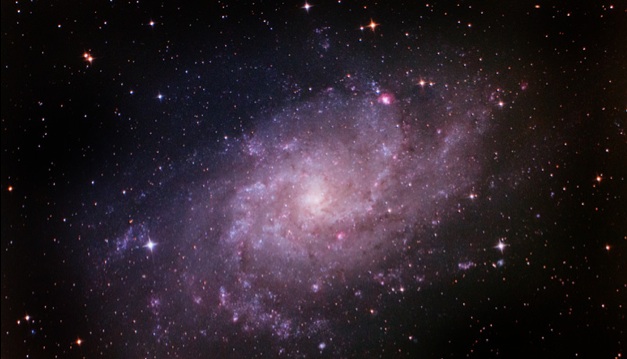M33: Facts About the Triangulum Galaxy

The Triangulum Galaxy (also known as M33) that is about 3 million light-years away from Earth. While its mass is not well understood — one estimate puts it between 10 billion and 40 billion times the sun's mass — what is known is it's the third largest member of the Local Group, or the galaxies that are near the Milky Way. Triangulum also has a small satellite galaxy of its own, called the Pisces Dwarf Galaxy.
Under dark sky conditions, M33 is just barely visible with the naked eye in the constellation Triangulum, just west of Andromeda and Pisces. To spot the galaxy, look for the constellation at:
- Right ascension: 2.11 hours
- Declination: 32.03 degrees
- Visible between latitudes 90 degrees and -50 degrees
Among the galaxy''s most distinctive features are ionized hydrogen clouds, also called H-II regions, which are massive regions of starbirth.
"Sprawling along loose spiral arms that wind toward the core, M33's giant H-II regions are some of the largest known stellar nurseries, sites of the formation of short-lived but very massive stars," NASA's Astronomy Picture of The Day website stated.
"Intense ultraviolet radiation from the luminous, massive stars ionizes the surrounding hydrogen gas and ultimately produces the characteristic red glow." [Triangulum Galaxy Dazzles in Stargazer's Photo]
History
Triangulum's official name of M33 would suggest at first that Charles Messier, who created the Messier catalog, was the one who discovered the galaxy. Messier was cataloging a list of deep-sky objects that were not comets in order to make searching for comets easier. M33 was noted on Aug. 25, 1764.
However, the European Southern Observatory adds that the discovery could have been made by Italian astronomer Giovanni Battista Hodierna sometime before 1654, when his book "De systemate orbis cometici" ("About the systematics of the cometary orbit") was published. Some accounts say that Hodierna made an oblique reference in the book that could be interpreted as an observation of the galaxy.
William Herschel (who is best known for discovering Uranus) also observed Triangulum in the late 1700s, and also noted a large region of gas within the galaxy that is today noted as NGC 604. M33 itself was considered a "spiral nebula," and it was unclear if M33 was part of the Milky Way Galaxy.
By the 1920s, observations by Edwin Hubble noted that M33 is a separate "stellar system" based upon observations of Cepheid variable stars. These stars are often used to measure cosmic distances in space because their luminosity is the same no matter where they are located.
Later observations of the galaxy revealed that it is approaching the Milky Way Galaxy at about 62,000 mph (100,000 kph). Some astronomers believe that Triangulum is "gravitationally trapped" by the massive Andromeda Galaxy that is also hurtling toward our galaxy, the European Southern Observatory stated.
Starbirth region
Among Triangulum's most distinctive features is NGC 604, a region of starbirth so big that the Space Telescope Science Institute once described it as "monstrous." Their 2003 estimate says that the gas cloud has more than 200 blue stars and that it is more than 1,300 light years across — or about 100 times bigger than the Orion Nebula. (More recent estimates peg it at 1,500 light-years.)
"If NGC 604 were at the same distance from Earth as the Orion Nebula, it would be the brightest object in the night sky (besides the moon)," NASA stated.
The young stars are extremely hot, at 72,000 degrees F (40,000 C), and the biggest ones are 120 times the mass of the sun. Radiation pumping out from the young stars floods into the gas in the region, making it fluoresce or glow, STScI added.
"Within our Local Group, only the Tarantula Nebula in the Large Magellanic Cloud exceeds NGC 604 in the number of young stars even though the Tarantula Nebula is slightly smaller in size," STScI stated.
Newer observations
Studying M33 in infrared light, NASA's Wide-field Infrared Survey Explorer (WISE) revealed hotspots of activity within the galaxy in 2011 while also showing that the center of the galaxy doesn't have much going on within it.
"Areas in the spiral arms that are hidden behind dust in visible light shine through brightly in infrared light, showing where clouds of cool gas are concentrated," NASA wrote at the time.
"There isn't a lot of star formation occurring near the center of M33. It would be difficult to deduce this lack of activity in the core by only looking a visible-light image, where the core appears to be the brightest feature."
NASA added that the galaxy looks "surprisingly bigger" than an optical image would make it appear, because cold dust is visible further in space than what astronomers initially expected.
Join our Space Forums to keep talking space on the latest missions, night sky and more! And if you have a news tip, correction or comment, let us know at: community@space.com.
Get the Space.com Newsletter
Breaking space news, the latest updates on rocket launches, skywatching events and more!

Elizabeth Howell (she/her), Ph.D., was a staff writer in the spaceflight channel between 2022 and 2024 specializing in Canadian space news. She was contributing writer for Space.com for 10 years from 2012 to 2024. Elizabeth's reporting includes multiple exclusives with the White House, leading world coverage about a lost-and-found space tomato on the International Space Station, witnessing five human spaceflight launches on two continents, flying parabolic, working inside a spacesuit, and participating in a simulated Mars mission. Her latest book, "Why Am I Taller?" (ECW Press, 2022) is co-written with astronaut Dave Williams.










